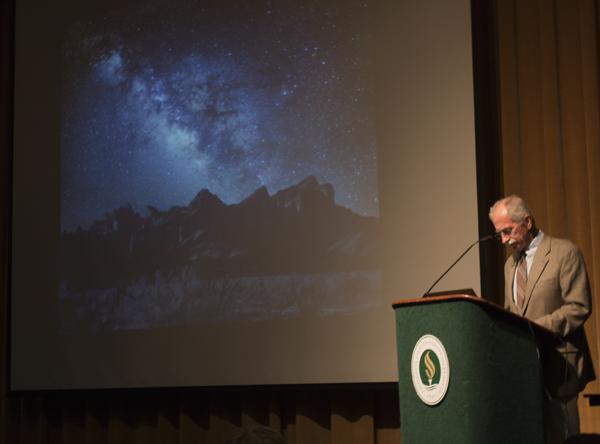Sac State geology professor presents lecture on exploring the universe for dinosaurs

Dr. Dale Russell, an adjunct professor, begins the STEM Scholars Lecture: Worlds to Discover, Exploring the Galaxy for Dinosaurs with an image of the Milky Way on Tuesday.
September 21, 2011
The Sacramento State adjunct professor, Dale Russell, presented a lecture Tuesday that theorized on how dinosaurs could be found surviving on other planets.
Entitled “Worlds to Discover: Exploring the galaxy for dinosaurs,” his presentation was part of the “Science, Technology, Engineering, and Mathematics,” lecture series.
He said that the komodo dragon and common emu may have evolved from dinosaurs, stating that the emu of today has a mouth almost identical to that of the ostrich dinosaur. Russell predicts that animals slightly dinosaurian may have repeatedly evolved.
“I was honored to be invited to present this lecture on June 28 of this year.” Russell said. “I had finished a book about year and a half ago, ‘Islands in the Cosmos: The Evolution of Life on Land.’ It provided a good deal of background thinking.”
He went on to speak about dinosaurs and how they evolved to survive. Dinosaurs in each hemisphere of the earth looked distinctly different from the other, evolving to fit their most common surroundings.
He also speculated on dinosaur life on other planets and what these animals may look like. Some planets with blue stars may have red leaves, meaning the dinosaurs would evolve to become red in order to camouflage themselves.
“The examination of other planets’ vegetation was really interesting,” said Sac State alumnus Lisa Burnett. “The description of how animals adapt to density and atmosphere was great. I really got an appreciation for the universe and how unique earth is.”
Russell said while dinosaurs were on earth, there were many other planets that had the same amount of water, if not more. Today, he said, these planets have burned off most of the water supply, or they have been completely covered with ice.
He speculated that in order to have dinosaurian life on other planets, scientists would have to find one that most resembles earth’s water and vegetation from when dinosaurs reigned here. Mars most resembles our Sahara desert and has the lowest chance for survival. There are an estimated 80 million planets in the galaxy and he said dinosaurs could be out there.
“The presenter’s ideas about what life on other inhabitable worlds would look like was very interesting,” said mathematics major Andrew Wong. “I had no idea that we had discovered that many planets with liquid water.”
Russell has been giving lectures for about 45 years within his field of study.
“This lecture has been on my mind for about three months,” Russell said. “Incidentally it took about five years to write (Islands in the Cosmos), which is about right for a book in science. Let’s say that I have prepared about 500 lectures altogether, but this will be my first lecture at Sac State,” Russell said.
Russell decided early on what profession he wanted to pursue.
“For me, at the age of about 7 I had decided to become either a farmer or a paleontologist,” Russell said.
He said paleontology won out and at the top of his list were dinosaurs.
“Although it is very difficult, teaching is classically a very honorable profession,” Russell said. “It still is. Among the greatest rewards of being alive is to learn – I am tempted to say that learning is like falling in love perpetually.”




























































































































